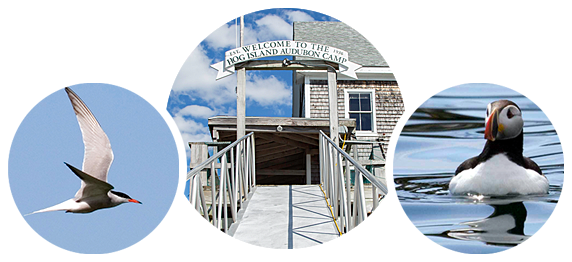By Tom Schaefer
When I first came to Hog Island as a camper in 1981, I was far enough along on a humanities degree that my next big hurdle was to complete the “project” phase of the program. Since my focus was on conservation history, I figured hanging out on an island in Muscongus Bay for two weeks, as the Audubon Camp program was back then, would provide a wonderful time for a guy from the Midwest to reflect and, I was sure, discover the absolutely right topic for that culminating graduate project. I can remember that I was mildly disappointed when, after having prowled around the camp compound for only a few hours, the project idea jumped up from the island itself and grabbed me. And I never would have guessed that Emily Dickinson would be at the heart of it all. But she was.
Mabel Loomis Todd, celebrated as savior of the island, was also the original editor of Emily Dickinson’s poetry back in the late 1880s.
The idea of attending the Audubon Camp in Maine came from a science teacher colleague who had attended the previous year on a scholarship from the local Audubon chapter. What a great idea, I thought, so I applied as well. I assumed that the Dayton Audubon Society targeted science teachers for their grants, so I held my breath until hearing that they had agreed to partially fund my humanities-based trip. I had also heard at just about that time in a graduate seminar on Dickinson that one of the students had visited Walt Whitman’s house while in Boston. Another great idea, I thought. I could stop by the Dickinson homestead in Amherst, Massachusetts, on the way to Hog Island. And I did. But that is another story. Suffice it to say that I had been smitten by Miss Dickinson’s life and work and was pretty excited to be traveling through New England to her home with the coast of Maine as my destination.
So there I found myself on that first Sunday afternoon on Hog Island. I was poking around, investigating camp buildings, but was really drawn to sitting on the rocky outcrop just north of the Fish House overlooking the bay. Although lobster was beyond my teacher’s salary, the look of the bouys dotting the bay was lovely, as was the view of neighboring islands, the sound of a lapping tide on the shore, and the fresh feel of a downeast sea breeze. The long drive from Ohio had already been rewarded. When I got up from where I was sitting, I noticed a sign just behind me giving notice that Hog Island was also called the Todd Wildlife Sanctuary. Something about that name seemed familiar, but I couldn’t quite place it. Soon after, while prowling around the Fish House, it hit me. The woman whose picture was framed on the knotty pine wall and celebrated as savior of the island, Mabel Loomis Todd, was the same Mabel Loomis Todd who was the original editor of Emily Dickinson’s poetry back in the late 1880s. Was it possible that my destination in Maine and my pilgrimage to the Dickinson homestead were connected? Indeed, they were.
To be sure, Emily Dickinson knew nothing of Hog Island. Mrs. Todd’s process of purchasing tracks of the island began years after Emily’s death and years after publication of Poems in 1890. Still, it is as clear to me now as was the Muscongus Bay air that Sunday afternoon, that the humanities played a key role in what would become the Audubon Camp in Maine.
With all of the fine natural history instruction and personal recreation that goes on at the Audubon Camp in Maine, it is good to see the humanities getting a share of the spotlight. Mabel, and Emily, I should think, would both be nodding in approval.
“The Epic of Hog”: The Todd-Bingham Family and the Establishment of the Audubon Ecology Camp in Maine is available through inter-library loan from Wright State University in Dayton, Ohio.
Tom Schaefer is a retired high school history teacher who completed his masters project on the history of Hog Island. Tom is former FOHI President and Editor of Across the Narrows.

